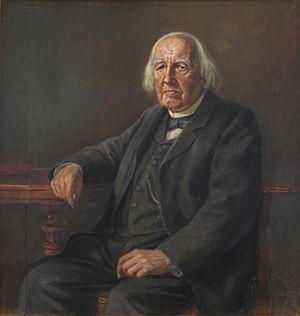Karl Weierstraß facts for kids
Quick facts for kids
Karl Weierstrass
|
|
|---|---|
| Karl Weierstraß | |

painting by Conrad Fehr , 1895
|
|
| Born | 31 October 1815 |
| Died | 19 February 1897 (aged 81) |
| Nationality | German |
| Alma mater | University of Bonn |
| Known for |
|
| Awards |
|
| Scientific career | |
| Fields | Mathematics |
| Institutions | Gewerbeinstitut |
| Doctoral students | |
Karl Theodor Wilhelm Weierstraß (born October 31, 1815 – died February 19, 1897) was a German mathematician. He is famous for making mathematics, especially a field called analysis, much more solid and logical. He used special math tools called power series to build strong foundations for many important ideas in math.
Weierstrass helped create the basis for theories like elliptic functions, differential geometry, and the calculus of variations. He believed that math definitions should be very clear and precise. He often pointed out when earlier mathematicians were too vague.
Contents
Who Was Karl Weierstrass?
Karl Weierstrass was a very important German mathematician. He lived during the 19th century. His work helped to make math more exact and reliable. He wanted to make sure that all mathematical ideas were built on strong, clear rules.
He is known for his work in mathematical analysis. This part of math deals with limits, derivatives, and integrals. He made sure these ideas had a very solid logical foundation.
Early Life and Education
Karl Weierstrass was born in Ostenfelde, which was part of the Kingdom of Prussia. This is in modern-day Germany. His father was a government official. Karl first studied law and finance at the University of Bonn.
However, he was much more interested in mathematics. He spent a lot of time studying math on his own. He later went to the University of Münster. There, he focused on mathematics. He became a high school teacher after finishing his studies.
His Big Ideas in Math
Weierstrass introduced new ways to define important math concepts. One of his most famous ideas is the (epsilon-delta) definition of a limit. This definition made the idea of a limit much more precise. It is still used today in calculus.
He also worked a lot with power series. These are like very long polynomials. He showed how they could be used to understand many different functions. This helped to solve problems in various areas of math.
The Bolzano-Weierstrass Theorem
A famous idea named after him is the Bolzano–Weierstrass theorem. This theorem is about sequences of numbers. It says that if you have an endless sequence of numbers that stays within a certain range, then some part of that sequence will get closer and closer to a specific point.
This theorem is very important in advanced math. It helps mathematicians understand how numbers behave. It is a key tool in the study of real numbers and complex numbers.
Teaching and Influence
Weierstrass was also a great teacher. He taught at the University of Berlin. Many students came from all over the world to learn from him. He had several famous students.
One of his most well-known students was Sofya Kovalevskaya. She was a brilliant female mathematician. Weierstrass supported her studies at a time when it was hard for women to get a university education. He helped her become a successful mathematician.
Awards and Legacy
Karl Weierstrass received many honors for his work. In 1895, he was awarded the Copley Medal. This is one of the highest awards in science. It is given by the Royal Society in London.
His ideas changed how mathematicians thought about analysis. He made the field much more rigorous. His work continues to influence mathematics today. He is remembered as one of the most important mathematicians of his time.
See also
 In Spanish: Karl Weierstraß para niños
In Spanish: Karl Weierstraß para niños

